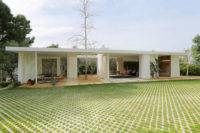Short Hills, New Jersey
The existing house 1920’s suburban house is set on a leafy knoll next to a pond. Its picturesque high gables and leaded windows belied problems inside—a cramped, dark kitchen with failing fixtures, ugly cabinetry, and cracked floor tiles. Initially the client had imagined renovating the kitchen and adding a sunroom. This option proved to be impractical as the only sympathetic site for an addition was on the north facade. The architects suggested that the existing kitchen should be converted into a den with a new 300-square-foot kitchen added to the north facade.
Design concept and solution:
The gable end of the house contained the dining room with the master bedroom above. The concept was to extend the house with a volume that corresponded exactly to the gable, thus maintaining the scale and form of the house. A band of glass was introduced to separate the existing structure from the new and further abstract the connection between the two. The resulting double-height space is flooded with natural light and is the antithesis of the cozy cottage interior aesthetic of the original house, together they balance and compliment each other. A single story glass corridor links the addition back to the new den and provides a new entry point for the back door.
The architects’ intention was to complement the existing house in volume and material, but not to copy it, to allow both the old and new to have their own integrity. In keeping with the simple design concept for the exterior of the addition the architects chose cedar siding, which matches the existing cedar roof shingles while contrasting with the house’s white stucco. Sliding glass panel doors replace the French windows at the north end of the dining room, opening that space up to the kitchen.
The interior of the kitchen is simple and abstract. A wall of cabinetry containing the refrigerator is flanked by two marble counters; one with double sinks in front of a 10-foot-tall window, and the other containing the oven. The wall cabinetry folds back to reveal additional counter space. The kitchen opens onto a small breakfast patio on one side and the new glass corridor on the other. Glass panel pocket doors replace the French windows at the north end of the dining room, opening that space up to the kitchen. Extremely light and airy, the space is shaded in the summer by overhanging mature deciduous trees and warmed in winter by radiant-heated limestone floors. The floor extends into the glass entry hall in which a white lacquered panel wall contains the coat closet and laundry.
Total construction cost: Withheld
People
Architect
Brian Messana, AIA partner in charge
Architect of record:
Interior designer:
Engineer:
General contractor:
Photographer:
CAD system, project management, or other software used: |
Products
Structural system:
Exterior cladding:
Windows
Glazing
Doors
Interior finishes
Paints and stains:
Floor and wall tile: |

















